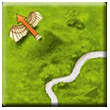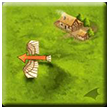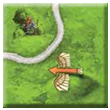The Flier
 |
You are reading the rules for this tile design. |  |
 | Read the following rules if your tiles look like this. |
| If your tiles have a different design, then choose a game from Spin-offs. |  |
Humanity has always been fascinated with flight. Now, your meeples can take to the skies, though you never know where they'll land.
General info and comments
The Flier (Mini #1) was released by HiG for the second edition, known as C2 for short, in 2017, bundled as part of ![]() Big Box 6. A third edition, known as C3 for short, was released in 2021 including more detailed graphics, cities with clipped buildings and some minor wording changes. The C3 version of this expansion is only available as part of
Big Box 6. A third edition, known as C3 for short, was released in 2021 including more detailed graphics, cities with clipped buildings and some minor wording changes. The C3 version of this expansion is only available as part of ![]() Big Box 7.
Big Box 7.
This expansion was originally released for the first edition, known as C1 for short, in 2012.
Contents
- 8 new landscape tiles with flying machines (identified with
 to help you separate and sort your tiles)
to help you separate and sort your tiles)
- 1 flight die (sides 1, 1, 2, 2, 3, and 3)
Rules
Preparation
Shuffle the new landscape tiles with those from the basic game and stack them normally. Place the die within easy reach of all payers.
Gameplay
1. Placing a tile
When a player draws a tile with an aircraft symbol, he or she plays it according to normal rules.
2. Placing a meeple
After placing a tile with a flying machine on it, you may choose to place a meeple either normally (and then follow all normal rules of placement) or on the flying machine.
When you place a meeple on the flying machine, [1] your meeple will move in a straight line in the direction that flying machine faces. Roll the flight die and move your meeple a number of tiles equal to the number of pips on the die (one to three tiles). Your meeple may be placed on any incomplete feature [2] on that tile, even if that feature is already occupied by other meeples. However, meeples placed by a flying machine can never be placed in a field, even if that field is unoccupied. [3] [4] [5] [6] [7]
Meeples placed by a flying machine immediately become the appropriate type (highwayman, knight, or monk).
If you cannot place your meeple on the designated tile (either because there are only complete features and fields, or because there simply isn't a tile in the designated location), the meeple is returned to your supply. You do not get to place another meeple this turn. [8]

Example 1: You place a tile with a flying machine, and decide to try placing a meeple on that flying machine (which is facing up and left).
You roll a 3. You cannot place a meeple this turn, because there is no eligible tile at the designated location.
Had you rolled a 2, you would be able to place your meeple on the monastery (even though a blue meeple occupies it) or the city (even though a yellow meeple occupies it). Choosing one of these two options would be mandatory. You could not have placed on the road, because it is already completed.
Additional clarifications
The following examples provide some additional clarifications on the available options to a flier. [9]

- Your flier cannot land on the road on the destination tile as it was just completed.
- Your flier can land on the unoccupied incomplete city. This is the only valid option in this case.

- Your flier cannot land on the road on the destination tile as it was just completed.
- Your flier can land on the unoccupied incomplete city. This is the only valid option in this case.

- Your flier can land on the road occupied by Blue, since it is incomplete. It doesn't matter it is already occupied.
- Your flier can land on the unoccupied incomplete road on the destination tile too.
3. Scoring a feature
Tile distribution
C3 Edition
C2 Edition
Footnotes
For Icons explanation and licensing please visit Icons page.
- ↑
 Any meeple (regular meeple, large meeple, mayor, wagon, ringmaster, guard meeple, abbot, phantom) can be a flier, as the flying machine feature is not the final resting place for the meeple. However, the final landing point must still be a valid feature for that meeple:
Any meeple (regular meeple, large meeple, mayor, wagon, ringmaster, guard meeple, abbot, phantom) can be a flier, as the flying machine feature is not the final resting place for the meeple. However, the final landing point must still be a valid feature for that meeple:
- The mayor can only land on an unfinished city. If an unfinished city is not available on the tile where the mayor lands, the mayor returns to the player’s supply. (2/2013)
- The abbot can only land on a monastery or a garden. (Yes, gardens are allowed despite the wording of the primary rule.) If an unfinished monastery or garden is not available on the tile where the abbot lands, the abbot returns to the player’s supply. (3/2015)
- Only a regular meeple can land on an acrobat space or on an incomplete acrobat pyramid.
- ↑
 A player cannot place a flier on a structure that was finished by the tile that was just placed, as a feature is considered completed at the moment that a tile is placed, and the flier can only land on an unfinished feature. (2012)
A player cannot place a flier on a structure that was finished by the tile that was just placed, as a feature is considered completed at the moment that a tile is placed, and the flier can only land on an unfinished feature. (2012)
- ↑
 This means a flier can land on any incomplete claimable feature on the destination tile but a field. It is irrelevant if the feature is occupied or not. As a consequence, a flier cannot land on another flying machine.
This means a flier can land on any incomplete claimable feature on the destination tile but a field. It is irrelevant if the feature is occupied or not. As a consequence, a flier cannot land on another flying machine.
- ↑
 The flier can land on features outside the city of Carcassonne (but not in the city itself) (
The flier can land on features outside the city of Carcassonne (but not in the city itself) ( Exp. 6 - Count, King & Robber) and outside the Wheel of Fortune (but not on the Wheel itself) (
Exp. 6 - Count, King & Robber) and outside the Wheel of Fortune (but not on the Wheel itself) ( The Wheel of Fortune). The flier can also be deployed to the roads on the school tiles (
The Wheel of Fortune). The flier can also be deployed to the roads on the school tiles ( The School). (1/2013)
The School). (1/2013)
 As a consequence of this clarification, the flier could also land on features outside the city of Leipzig but not in the city itself (
As a consequence of this clarification, the flier could also land on features outside the city of Leipzig but not in the city itself ( The Markets of Leipzig).
The Markets of Leipzig).
- ↑
 A flier cannot land on a magic portal. (2/2013)
A flier cannot land on a magic portal. (2/2013)
- ↑
 A flier cannot land on a castle (
A flier cannot land on a castle ( Exp. 8 - Bridges, Castles & Bazaars), since it is not placed on a particular tile.
Exp. 8 - Bridges, Castles & Bazaars), since it is not placed on a particular tile.
- ↑
 Tower floors are not part of a feature that could be claimed and scored. As a consequence, fliers should no be allowed to land on them.
Tower floors are not part of a feature that could be claimed and scored. As a consequence, fliers should no be allowed to land on them.
- ↑
 This means that a meeple using a flying machine must be placed on the target tile, or return to its owner's supply if the placement is not possible.
This means that a meeple using a flying machine must be placed on the target tile, or return to its owner's supply if the placement is not possible.
- ↑
 These clarifications are based on the examples provided by Kettlefish on Carcassonne Central:
These clarifications are based on the examples provided by Kettlefish on Carcassonne Central:
http://www.carcassonnecentral.com/community/index.php?topic=3972.msg58622#msg58622 (6/2018) - ↑ Jump up to: 10.0 10.1
 Flying machines allow several meeples to share features normally occupied by only one meeple. If so, the players with the majority will score the feature. This may happen with:
Flying machines allow several meeples to share features normally occupied by only one meeple. If so, the players with the majority will score the feature. This may happen with:
- Monastery
- Abbey
- Shrine
- Darmstadt Church
- German monastery (meeples placed as monks and meeples placed as abbots are scored separately)
- Dutch & Belgian monastery (meeples placed as monks and meeples placed as abbots are scored separately)
- Japanese Building (meeples placed as monks and meeples placed as abbots are scored separately)
- Garden
- German Castle
- German Cathedral
- Cemetery
- Haunted Castle




























